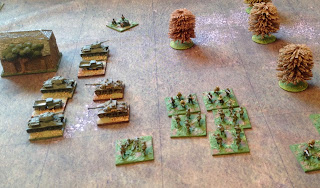A new set of rules from Sam Mustafa will always be high on my wish list, but do we really need another set of WW2 rules? The answer is probably yes, because Sam has found a niche in a crowded market for a set of rules that is for the really big games at corps level, or even higher.
The main criticism of the rules is that they are more a boardgame than a tabletop wargame with miniatures. It is the case that some of the mechanics have a board game feel to them, and of course the use of a square grid adds to that impression. However, if you use miniatures this is still a wargame and he is not alone in championing the use of grids to speed up play. Simon Miller's 'To the Strongest' is a case in point and few would argue that is a boardgame.
This isn't a cheap set of rules (I paid £32), even if that is probably due to the rate of exchange. There is also a much cheaper PDF download version. For your money, you get a high quality publication and plenty of free online support from the website. Army lists for the main combatants are in the book.
You can play without miniatures using unit cards, or you can use the template to put miniatures on the cards. Alternatively, as I did, you can put the stats on the roster and play with miniatures like any other wargame. You will need a playing surface divided into squares, which represent a square kilometre. I decided to use my 10mm WW2 collection and used 10cm squares, if you want to use 15mm then a 6" square will be necessary. This means you can get a decent size game on a 4' x 3' mat - mine came from those sold for 'To The Strongest', made by Deep Cut Studios. You will also need some markers and a command post for each army, downloadable for free from the website.
A unit is a reinforced company and each unit has a three stage combat track, plus an armour strength for tank units. Artillery units have a range and barrage value. They also have traits like leg infantry, armoured infantry and so on.
The command post sheet is the key to the game. Each army starts the game with ops dice that can be replenished during the game. These can be spent on road movement, tactical movement or a list of events and tactics. They can only be used once, unless you reset at a start of a bound, but if you do so you get fewer ops dice. This allows you to use your ops dice to focus on a particular attach, but you will never have enough to do everything you want. This really does put you into the role of corps commander.
The games mechanics on the tabletop are straightforward and fast with the use of square grids. Typically infantry move one square and motored units two squares. Road movement is faster, but you need to keep well away from the enemy, or pay the price in combat values.
Combat is resolved by adding the values of the units in contact (there on no ranged attacks due to the game scale), rolling a dice that gives you a column on a table and then applying shifts due to a small number of factors and tactics you pay ops dice for. This does feel like a boardgame mechanic, but it is simple and quick. Having said that, combat can run on for several moves, not least because the stacking rules limit the number of units in a square. If the attacker doesn't destroy all the enemy units in a square, it has to retreat one or more squares.
That is the basic game, but there are advanced rules for engineering , airborne, beach landing etc.
The chapter on army lists explains the points system, so you can create those obscure units we all love to have. The basic building block is the battalion and that is fixed. Then you can pick how many you want for each 'element', typically a regiment, brigade or kampfgruppe. There are limitations on numbers and attachments to create historically realistic forces. The lists are also divided into early, mid or late war periods.
Finally, there are a number of basic scenarios to get you started.
So, onto the tabletop. I used late war German and Soviet armies. A typical game might have between 80 and 110 points, but for this starter game I used 65 a side. This paid for two tank brigades and an infantry division for the Soviets, and a panzer and infantry kampfgruppe for the Germans.
These are the starting positions, Soviets on the right.
Close up of the action in the centre - Panthers v T34s. The grids don't really dominate the look of the tabletop.
The wider action on the right. Terrain is marked by a single model building for a built up area, or a tree for a wood. Remember a square covers a large area, a kilometre.
Action on the left flank with Pkw IVs and panzer grenadiers.
The Soviets breakthrough in the centre and start to roll up the German left.
My overall view is that the rules are well laid out and quick to understand. The subtleties will take a bit more practice, particularly on how to use the ops dice. It certainly gives the feel of a big battle and so is very different from other WW2 rules, like Blitzkrieg Commander or Spearhead that I typically use with these models. Dismissing it as a boardgame, misses the point. It's a different game and one that is a very welcome addition to my rules bookshelf.













